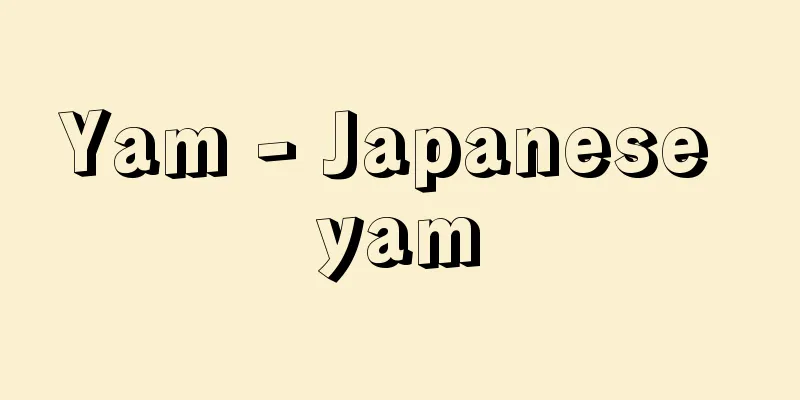Yam - Japanese yam

|
A perennial vine of the Dioscoreaceae family (APG classification: Dioscoreaceae). The stems are long and slender, growing to several meters, branching and twining around other plants. The leaves are opposite. The shape of the stems and leaves is very similar to that of the Chinese yam cultivated in fields, but the Chinese yam has a red spot where the leaf blade and petiole meet, whereas the Chinese yam does not, making it possible to distinguish it from the Chinese yam. Dioecious. In July and August, the inflorescences grow in the leaf axils. The male flower spikes are upright in groups of two or three, about 5 cm long, and bear many small white flowers. The female flower spikes are about 10 cm long and droop. The fruit is a capsule with three wings about 1 cm in diameter, with three lobes, each containing two seeds. When the fruit wall splits in late autumn, flat, circular seeds with thin wings are scattered. In summer and autumn, spherical or oblong bulbils about 1 cm in diameter appear in the leaf axils at the top of the stem, which drop to the ground and become reproductive plants. Underground, tubers, or rhizophores, form. The tubers can grow to over 1 meter in length, are thin near the ground, and become thicker and twisted the deeper they go, being thinner than Chinese yam. The flesh of the tuber is white and sticky. In the spring, sprouts appear from the top of the tuber, which disappears by summer and new tubers appear by autumn. In the past, when people spoke of potatoes, they meant this species, but from the beginning of agriculture in Japan, the cultivated potatoes were called taro, while this species came to be called yamanoimo (mountain potato) or simply yamaimo (mountain yam). It is also called jinenjo (natural yam), meaning a potato that grows naturally. It is a popular wild vegetable in the fall and winter. [Hoshikawa Kiyochika October 19, 2018] usePotatoes are very sticky, so they are grated and seasoned to make tororo soup. They are also used in stews and potato porridge. The ingredients are about 70% water, 2.8% protein, 0.7% fat, 26% carbohydrates, and 1% ash. There is 540 milligrams of potassium per 100 grams, which is slightly more than potatoes and sweet potatoes. Vitamins include B1 , B2 , niacin, and C. Potatoes have a unique stickiness. They are excellent in nutrition, and have been considered a food that gives energy since ancient times. Another characteristic is that they contain diastase, which is why the custom of pouring tororo soup over barley rice, which is difficult to digest, has a digestive effect. Cultivation is also popular, and one farming method involves growing potatoes in pipes buried in the ground to make them easier to harvest. In traditional Chinese medicine, the potato is called san'yaku, and in addition to its nourishing and strengthening properties, it is also grated and used externally to treat swelling, burns, frostbite, toothache, etc. [Hoshikawa Kiyochika October 19, 2018] cultureThe modern yam is often called by its common name, including the cultivated species , Dioscorea batatas Decne., but Nagaimo is native to China and has been recorded since the Edo period, and before that, Yamaimo was the wild yam, also known as Jinenjo. The Shinsen Jikyo (c. 901) gave the Chinese name Shoyo the name Yamaimo, and the Wamyō Ruijūshō (c. 931-938) wrote that Shoyo was also called Yamaimo, Yamatuimo, or Yamanoimo in common parlance. It is believed to have been eaten since prehistoric times, but no archaeological evidence has yet been found. Its earliest written mention is in the Izumo no Kuni Fudoki (733), where it is mentioned as one of the plants growing in the mountains and fields of Ohara County. In the Engishiki (927), it is mentioned as a grass mochi (kusamochi) and a herbal medicine. It is also used in porridge, and this variety was used for yam porridge before the introduction of sweet potatoes in the Edo period. Akutagawa Ryunosuke wrote "Imogayu" (Potato Congee) based on the yam porridge in the Konjaku Monogatari (Tales of Times Now Past and Present) (12th century). [Hiroshi Yuasa October 19, 2018] [Reference] | | |©Shogakukan "> Ginenjo (cultivated) Source: Shogakukan Encyclopedia Nipponica About Encyclopedia Nipponica Information | Legend |
|
ヤマノイモ科(APG分類:ヤマノイモ科)の多年生つる草。茎は細長く、数メートルに伸びて分枝し、他物に絡みつく。葉は対生。茎葉の形状は畑に栽培されるナガイモと酷似するが、葉身と葉柄の接点にナガイモは赤斑(せきはん)があるが、ヤマノイモには赤斑はないので区別することができる。雌雄異株。7~8月、葉腋(ようえき)から花序を出す。雄花穂は2、3本ずつ直立して長さ約5センチメートル、白い小花を多数開く。雌花穂は長さ約10センチメートルで垂れ下がる。果実は直径1センチメートルほどの3枚の翼をもった蒴果(さくか)で、3室があり、各室に2個の種子がある。晩秋に果壁が裂けると円形の薄い羽をもった扁平(へんぺい)な種子が飛散する。また夏秋には茎の上方の葉腋に、径約1センチメートルの球・長球形のむかごがつき、地面に落ちて、繁殖子となる。地下部には、いも、すなわち担根体ができる。いもは長さ1メートル余にもなり、地際(じぎわ)は細く、深い所ほど太くよじれており、ナガイモより細い。いもの肉質は白く粘りが強い。このいもの頂部から春に萌芽(ほうが)し、いもは夏までに消失して秋までに新しいいもができる。 古くは、いもといえば本種のことであったが、農業開始のころから日本に入って栽培化されたいもを里芋と称したのに対し、本種はヤマノイモ(山の芋)、または単にヤマイモ(山芋)とよばれるようになった。また、自然に生えるいもの意味でジネンジョ(自然薯)ともよばれる。秋冬の山菜として好まれている。 [星川清親 2018年10月19日] 利用いもは粘りが強いのですりおろし、調味してとろろ汁にする。そのほか煮物、いも粥(がゆ)などにする。成分は水分約70%、タンパク質2.8%、脂質0.7%、炭水化物は26%、灰分1%。カリウムは100グラム中540ミリグラムで、ジャガイモ、サツマイモよりやや多い。ビタミンはB1、B2、ナイアシン、Cなどを含む。独特の粘りがある。栄養的に優れ、古来、精のつく食物とされている。またジアスターゼを含むのも特徴で、消化の悪い麦飯にとろろ汁をかけて食べる風習は、消化促進の効果をもつわけである。 栽培も盛んで、土に埋めたパイプの中でいもを成長させて収穫しやすいようにする農法もある。 漢方ではいもを山薬(さんやく)とよび、滋養強壮の効果のほか、すりおろして腫(は)れ物、やけど、しもやけ、歯痛などに外用される。 [星川清親 2018年10月19日] 文化現在のヤマノイモは栽培種のナガイモDioscorea batatas Decne.も含めて俗称されることが多いが、ナガイモは中国原産で、江戸時代から記録され、それ以前の山芋は自生のヤマノイモ、別名自然薯(じねんじょ)である。『新撰字鏡(しんせんじきょう)』(901ころ)は中国名の薯蕷(しょよ)に山伊毛(やまいも)をあて、『倭名類聚抄(わみょうるいじゅしょう)』(931~938ころ)は「薯蕷一名山芋、夜萬都以毛(やまついも)、俗にいう山乃以毛」とした。有史前から食用にされたと思われるが、考古学的な証拠はまだみつかっていない。文献上は『出雲国風土記(いずものくにふどき)』(733)に大原郡の山野の草木の一つとして取り上げられているのが、もっとも古い。『延喜式(えんぎしき)』(927)では、草餅(くさもち)や生薬(しょうやく)として名がある。粥(かゆ)にも入れられ、江戸時代にサツマイモが導入される以前の芋粥は本種が使われた。芥川龍之介(あくたがわりゅうのすけ)は、『今昔物語』(12世紀)のヤマノイモの粥をもとに『芋粥』を書いた。 [湯浅浩史 2018年10月19日] [参照項目] | | |©Shogakukan"> ジネンジョ(栽培もの) 出典 小学館 日本大百科全書(ニッポニカ)日本大百科全書(ニッポニカ)について 情報 | 凡例 |
<<: Okura Yamanoue - Okura Yamanoue
Recommend
Ur's Standard - Ur's Standard
...Many of his works were made using the techniqu...
Locustella lanceolata (English spelling) Locustella lanceolata
…[Higuchi Hiroyoshi]. … *Some of the terminology ...
Endothermic reaction - Endothermic reaction
A chemical reaction is a reaction that absorbs he...
Country of origin - Denseki
〘Noun〙 In the Ritsuryo system, the family name and...
Alpha brass - Alpha brass
…Alloys containing up to 35% zinc are alpha-phase...
Takashina Takako
Year of death: 2.10 (996) Year of birth: Unknown. ...
Procaine hydrochloride - Ensanprocaine
It is a local anesthetic designated as a highly t...
Updike, John
Born March 18, 1932 in Reading, Pennsylvania [Died...
Oya Gold Mine
...The main industries are agriculture, forestry,...
Gojo Yorimoto
A Southern Court official and military commander....
Issenshoku - Issenshoku
〘Noun〙 = Issenzori (One-sen shave) ※The history of...
Ijora Factory - Ijora Factory
…It is located 26 km southeast of St. Petersburg ...
Navy - Suigun
They were called kaizoku-shu, kego-shu, funate-sh...
Kinoshita Rigen - Kinoshita Rigen
Poet. Born in Okayama Prefecture. Real name Toshi...
London Metal Exchange; LME
A non-ferrous metals exchange in London. Seven ite...









